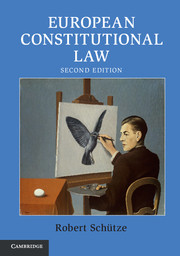Book contents
- Frontmatter
- Dedication
- Summary Contents
- Contents
- List of Illustrations
- List of Tables
- List of Cases
- List of Secondary Law
- Table of Equivalents
- List of Abbreviations
- Acknowledgements
- Introduction: European Constitutional Law
- Part I Constitutional Foundations
- Part II Governmental Powers
- 7 Legislative Powers: Competences and Procedures
- 8 External Powers: Competences and Procedures
- 9 Executive Powers: Competences and Procedures
- 10 Judicial Powers I: (Centralised) European Procedures
- 11 Judicial Powers II: (Decentralised) National Procedures
- 12 Judicial Powers III: EU Fundamental Rights
- Appendices
- Index
- References
8 - External Powers: Competences and Procedures
from Part II - Governmental Powers
- Frontmatter
- Dedication
- Summary Contents
- Contents
- List of Illustrations
- List of Tables
- List of Cases
- List of Secondary Law
- Table of Equivalents
- List of Abbreviations
- Acknowledgements
- Introduction: European Constitutional Law
- Part I Constitutional Foundations
- Part II Governmental Powers
- 7 Legislative Powers: Competences and Procedures
- 8 External Powers: Competences and Procedures
- 9 Executive Powers: Competences and Procedures
- 10 Judicial Powers I: (Centralised) European Procedures
- 11 Judicial Powers II: (Decentralised) National Procedures
- 12 Judicial Powers III: EU Fundamental Rights
- Appendices
- Index
- References
Summary
Introduction
The constitutional distinction between internal and external affairs emerges with the rise of the territorial State. With political communities becoming defined by geographical borders, foreign affairs would refer to those matters that entailed an ‘external’ dimension. The recognition of foreign affairs as a distinct public function received its classic formulation in the political philosophy of John Locke. Locke classified all external competences under the name ‘federative’ power, that is: ‘the power of war and peace, leagues and alliances, and all the transactions with all persons and communities without the commonwealth’.
This definition reveals the classic scope of the foreign affairs power. It was the power to decide over war and peace. The treaty power is here principally perceived as an appendage to the right of war. Foreign affairs were consequently considered part of the executive power. For relations between States were thought to have remained in a ‘natural state’. And their ‘law-less’ character provided an argument against the allocation of external powers to the legislative branch.
In the modern world, this reasoning is not as persuasive as 300 years ago. The military connotations behind foreign affairs have partly been replaced by the rise of the international treaty as a ‘legislative’ instrument. With the internationalisation of trade and commerce in the eighteenth century, a new foreign affairs occupation became consolidated: regulatory international agreements. The amount of tariffs for goods needed to be regulated; river navigation had to be coordinated; and intellectual property rights required to be protected. This development led one of the drafters of the 1787 US Constitution to suggest placing the treaty-making power ‘in between’ the rival constitutional claims of the executive and the legislative department.
Globalisation and the economic interdependence in the twenty-first century have much intensified the need for – peaceful – legal coordination between States. Yet, the Union is not a State – it is a Union of States. Is it nonetheless entitled to partake in the international affairs of the world? This depends – of course – on the structure of international law, as well as the European Treaties themselves. The 1957 Treaty of Rome had already acknowledged the international personality of the European Community, and the Treaty on European Union grants such legal personality to the Union.
- Type
- Chapter
- Information
- European Constitutional Law , pp. 263 - 301Publisher: Cambridge University PressPrint publication year: 2015



